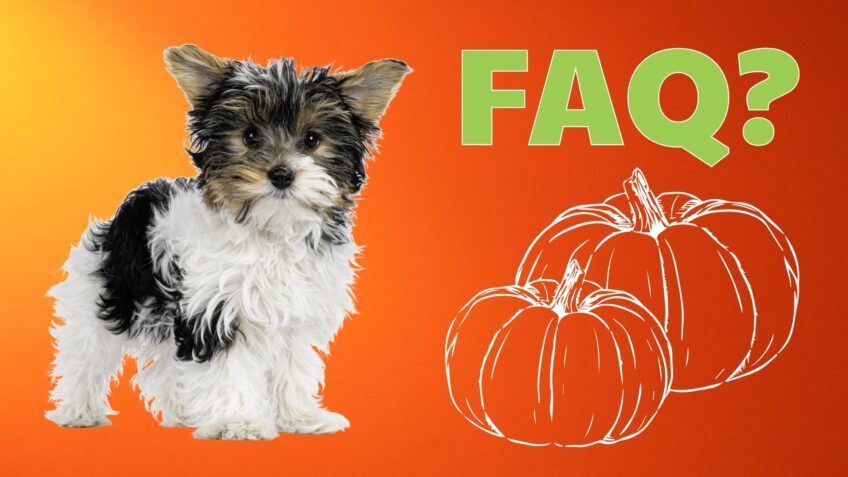Pumpkin is a safe, nutritious, and delicious treat for our canine companions. From an explanation of why pumpkins are beneficial to guidelines on dosage and serving options, here’s a quick look at how much pumpkin to feed your pup.
They contain high levels of dietary fiber with is important for regulating digestion. The seeds are a valuable source of protein, fats, vitamins, and minerals. The flesh is rich in beta-carotene and lutein which help support eye health. As a bonus, the insoluble fiber found in it may also help with overall digestive health as it helps to absorb toxins and reduce constipation as well as an issue caused by occasional bouts of diarrhea.
When introducing your pup to pumpkin, start by making it an occasional treat—no more than once or twice per week. Introduce it gradually into their diet using one teaspoon mixed into their regular food at each meal before gradually increasing the amount up to ¼ cup per day maximum or 2 tablespoons per 10lbs body weight.
Nutritional Benefits of Pumpkin
When it comes to your pup’s diet, many pet owners include pumpkin for its numerous benefits. Not only is pumpkin high in dietary fiber and low in fat but it is also packed full of vitamins and minerals. Vitamins A, E, and C are among the most prominent vitamins that can be found in pumpkins -all of which assist with a multitude of bodily functions including the immune system, cell metabolism, and vision health. Without enough of these essential nutrients, your pup may suffer from issues such as decreased energy levels or skin irritation.
It is a great source of iron which helps transport oxygen throughout your pet’s body. It also contains potassium and magnesium which helps to regulate digestion while providing energy to your pup’s muscles. Finally, the fiber found within pumpkins helps add bulk to your pup’s stool aiding in proper bowel movements -often helping with issues such as constipation or even diarrhea!
There are other benefits that can be obtained through consuming a suitable amount of pumpkin- such as improved skin health & coat shine (due to its Vitamin A content) as well as balanced blood sugar levels (which has been known to aid diabetic pets). With all these superb advantages in mind- how much pumpkin should you give your pup? This will depend on their size as well as their weight- but generally speaking- one spoonful per day for smaller dogs & three spoonfuls for larger breeds is an acceptable amount for most pups!
How Much You Should Give
It is a great source of nutrition for dogs, but it’s important to give it in moderation, especially for smaller breeds. When considering how much pumpkin to give your small dog, you should start with about a teaspoon per 10 pounds of body weight per day and progress up to approximately 1 tablespoon for the same weight. It’s important to introduce pumpkin gradually due to its high fiber content.
When choosing the type, canned pumpkin is easier for dogs to digest than a fresh one because it has been cooked. Look for pure pumpkin puree with no added sugar or spices. If you choose dehydrated forms such as powder or pellets, measure out a minimum of ¼ teaspoon per 10 pounds of body weight as a starter dose and adjust as necessary based on your dog’s reaction and health condition.
It’s important to watch out for any signs of allergies or adverse reactions after giving your dog this vegetable, such as vomiting or changes in stool appearance. If any allergies appear, contact your veterinarian immediately.
Remember that they should make up no more than 10% of your dog’s dietary intake and should be an intermittent treat. An excess of pumpkin can lead to digestive issues such as diarrhea or vomiting in some dogs. When giving canned pumpkin, gradually increase the amount over several days for the best results.
For small dogs, a canned pumpkin is a good option, while fresh-cooked pureed pumpkin is preferred for most nutrients. Offer pumpkin treats in moderation and watch for signs of distress. Always make sure that the pumpkin is cooked and has cooled down before serving it cold from the refrigerator. By following these guidelines, you can safely add pumpkin to your small dog’s diet and help support their digestive health.
How to Serve Pumpkin
It’s important to remember not to overdo it and make sure that pet owners follow the right proportion. Pumpkin can provide an amazing range of health benefits and should always be given in moderation.
The recommended serving size for a dog is 1/4 cup per 10 lbs of body weight (meaning 4-5 lbs of pumpkin per 40-50lb dog). When providing this vegetable to your dog, it’s best to stick with plain canned pureed type, without any added sugar or spices. It’s also worth noting that cooked fresh pumpkin or mashed sweet potatoes are alternative options but should be served in much smaller amounts than canned pureed options as they contain more calories and carbohydrates.
When introducing your pup to their first pumpkin snack, always start small with a tablespoon of pureed canned one where appropriate for their weight and size. You can then monitor their response before increasing the amount day by day. The key takeaway here is that practices like portion control should be monitored carefully when introducing any new dietary changes into your pet’s diet including this vegetable also!
Cautions and Side Effects
When feeding this vegetable to your pup, there are a few cautions and potential side effects you should be aware of. Firstly, make sure the type of pumpkin you are offering is safe for dogs. Canned pumpkin is ideal, as it is found in specialty pet stores and is specifically designed with all the necessary ingredients that your pup’s diet requires. Avoid using ones designed for human consumption as they may contain additional ingredients such as sugar or spices that can be harmful to dogs.
Secondly, always make sure to use 100% pure canned pumpkins without added sugar syrup, salt, or any other additives. This includes avoiding already prepared foods such as pie mix or filling that contains gelatin or thickeners, as these can be dangerous for pets.
Lastly, proceed with caution when introducing new foods into your pup’s diet, and always consult a veterinarian before making any sudden changes. Monitor your pup closely after adding canned pumpkin to his/her diet — watch out for signs such as diarrhea or vomiting that could indicate an allergic reaction or digestive issue.
Common Myths and Misconceptions About Feeding Pumpkins to Dogs
There are many common myths and misconceptions surrounding the feeding of pumpkins to dogs. Here are some of the most prevalent myths and the truths behind them:
Myth #1: Pumpkin is only good for digestive issues
While it’s true that it can be a great aid in relieving digestive issues, such as constipation or diarrhea, it has other nutritional benefits for dogs as well. It is high in vitamins A and C, fiber, and antioxidants, which can all contribute to a healthy immune system, skin and coat, and overall well-being.
Myth #2: Pumpkin will give my dog worms
This is a common myth with no truth behind it. This vegetable does not contain any substances that would cause a dog to get worms.
Myth #3: Pumpkin can replace a dog’s regular food
While it can be a healthy addition to a dog’s diet, it should not be a replacement for regular dog food. Dogs require a balanced diet that includes protein, carbohydrates, and fats in the right proportions, and pumpkin alone does not provide all of these nutrients.
Myth #4: Canned pumpkin is bad for dogs
This can be a safe and convenient option for dogs, as long as it does not contain any added sugars or spices. Make sure to check the ingredients label and choose a pure pumpkin product.
Myth #5: Only certain breeds of dogs can eat pumpkin
All breeds of dogs can benefit from it in their diet, as long as it is given in appropriate amounts and does not cause any adverse reactions.
Myth #6: Pumpkin is toxic to dogs
It is not toxic to dogs, and when given in appropriate amounts, is generally safe for dogs to consume.
By understanding the myths and misconceptions surrounding pumpkins and dogs, pet owners can make informed decisions about incorporating pumpkins into their dog’s diets. Always consult with a veterinarian before making any changes to your dog’s diet, and be mindful of portion sizes to ensure that your dog is getting the appropriate amount of nutrients without overeating.
FAQs

How should I serve pumpkin to my dog?
It can be served fresh, canned, or in dehydrated forms such as powder or pellets. Always make sure that it is cooked and has cooled down before serving it cold from the refrigerator.
How can I tell if my dog is having an allergic reaction to pumpkins?
Watch out for any signs of allergies or adverse reactions after giving your dog pumpkins, such as vomiting, change in stool production or appearance, rash, hives, redness around the eyes/skin, and changes in behavior. If any allergies appear, contact your veterinarian immediately.
How long does it take for a pumpkin to work on my dog’s digestive issues?
It should start working within a few hours to relieve digestive issues such as constipation or diarrhea, but it may take longer for other benefits to take effect.
How should I store pumpkins for my dog?
They can be stored in the refrigerator for up to a week, while fresh ones should be stored in a cool, dry place.
Can pumpkins treat urinary tract infections in dogs?
While they can help with digestive health, it is not a treatment for urinary tract infections in dogs. Consult with your veterinarian for appropriate treatment.
Can pumpkins help with weight loss in dogs?
Supplementing a dog’s diet with it can help them with weight loss goals when accompanied by exercise and a veterinarian-approved balanced diet plan specifically tailored for their individual needs over time.
Conclusion
While all this information and considerations are important, it is important to remember the basics of feeding your dog. A healthy diet is best for your pet and it’s not just about the food — you should make sure he has access to plenty of fresh water and spends time playing for exercise.
Be sure to always consult with your veterinarian regarding any potential dietary changes for your pet, including incorporating pumpkin. With their advice as a guide, you can use canned pumpkin as a delicious and nutritious addition to your dog’s diet and help them stay happy and healthy!

